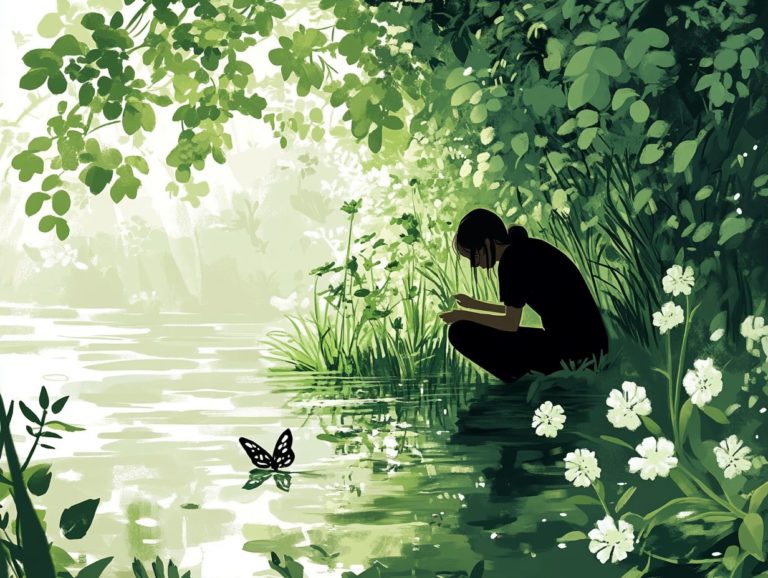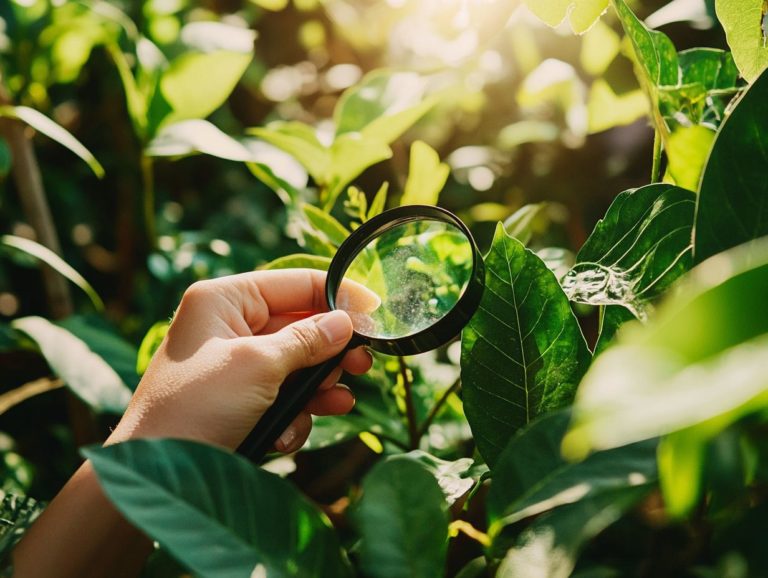5 Tips for Identifying Wild Flowers
Identifying wildflowers can be a rewarding activity. Whether you re a hiker, a nature lover, or just curious about the plants around you, this is for you!
Countless species flaunt vibrant colors and unique traits. Learning to identify them will enrich your outdoor adventures and deepen your appreciation for nature.
This article offers five practical tips for identifying wildflowers. It also highlights the importance of accurate identification and common mistakes to avoid.
You ll find tools and resources that enhance your knowledge and support wildflower conservation efforts. Dive in and discover the breathtaking beauty of your local wildflower landscape!
Contents
- Key Takeaways:
- 1. Look for Unique Characteristics
- 2. Take Note of the Habitat
- 3. Use a Field Guide or Identification App
- 4. Take Photos and Compare to Online Resources
- 5. Consult with Local Experts or Botanical Gardens
- Why Is It Important to Properly Identify Wild Flowers?
- Frequently Asked Questions
- What are some useful tips for identifying wild flowers?
- Can I use only one of these tips to identify a wild flower?
- Are there any other factors to consider when identifying wild flowers?
- Can I identify wild flowers just by looking at pictures?
- Do I need any specific tools for identifying wild flowers?
- Is it possible to identify every wild flower?
Key Takeaways:

- Look for unique characteristics, like petal shape and color, to identify wildflowers.
- Note the habitat and growing conditions to assist in identification.
- Use field guides or identification apps for help in identifying wildflowers.
1. Look for Unique Characteristics
As you explore wildflowers during blooming season, seek unique traits like petal shape and arrangement. These observations enhance your outdoor experience and can also aid in identifying common wild herbs in your area.
Wildflowers are incredibly diverse, showcasing colors from brilliant yellows to soft whites. Petal shapes vary too, from the delicate Bluebell to the open blossoms of the Wild Sunflower.
Pay attention to flowers like the California Poppy, which signals spring, or the Black-eyed Susan, a summer favorite. Recognizing these attributes makes it easier to appreciate specific species in their natural habitats.
2. Take Note of the Habitat
Observing the habitats where wildflowers grow is vital for understanding their growth patterns. You ll find these plants in vibrant gardens and roadside patches where nature thrives.
In meadows and forests, wildflowers play important roles in supporting insects that help plants reproduce and improving soil health. Knowing their habitats aids in species identification and conservation efforts.
3. Use a Field Guide or Identification App
A field guide or an app like Botany Buddy or LeafSnap can boost your confidence in identifying wildflowers. Additionally, learning 5 ways to remember edible plant characteristics can enhance your skills. These tools provide high-resolution images and detailed descriptions, making it easy to recognize flowers.
Think of it as having a helpful companion in your pocket! Choose an app that aligns with your interests, whether you re exploring local parks or preparing for a hike.
4. Take Photos and Compare to Online Resources

Taking photographs of wildflowers is a splendid way to capture their beauty and unique characteristics. This makes it easier to compare them with various online resources for accurate identification.
As you delve into this, you can showcase intricate details like petal textures and color variations. These might slip past your notice at first glance. This exploration into close-up photography deepens your appreciation for these natural wonders and helps you identify native species, essential for conservation efforts.
Get ready to discover websites like iNaturalist and the Native Plant Society. They offer very helpful identification tools and comprehensive databases. Conservation organizations like the Xerces Society and Audubon Society also provide resources aimed at protecting local flora and fauna. This emphasizes the interconnectedness of ecosystems and the vital importance of preserving native species.
5. Consult with Local Experts or Botanical Gardens
Consulting with local experts or visiting botanical gardens can provide you with valuable insights into wildflower identification and conservation efforts in your area.
Engaging with the community through organized wildflower hikes and events will significantly enhance your understanding of these beautiful plants. These experiences help you connect with fellow nature enthusiasts and knowledgeable conservationists.
You ll benefit from hands-on learning about various wildflower species while enjoying the shared enthusiasm of the group. Such involvement can ignite your passion for environmental stewardship and motivate you to advocate for the preservation of native flora and habitats.
By growing a network of like-minded individuals, you ll foster lasting friendships and contribute to a strong community dedicated to protecting the natural surroundings you cherish.
Why Is It Important to Properly Identify Wild Flowers?
Properly identifying wildflowers is essential for several reasons. It enhances your appreciation for nature and contributes to conservation efforts.
By learning to recognize different species, you become a more effective steward of your local landscapes. This knowledge helps you discern which plants are native and which are invasive.
Understanding these impacts on surrounding wildlife will aid in preserving local habitats. You can equip your community with tools to advocate for biodiversity initiatives, which are efforts aimed at protecting different species and their habitats.
Accurate identification can enrich educational programs, making environmental science more relatable and engaging. As you develop a passion for these plants, you ll feel more inclined to support conservation practices and participate in local initiatives aimed at protecting and restoring natural ecosystems.
What Are Some Common Mistakes When Identifying Wild Flowers?
Common mistakes in wildflower identification often arise from misinterpreting unique characteristics, like confusing similar-looking petals and buds.
This confusion can be heightened by environmental factors, such as varying lighting conditions and background flora. These may distort your perception of a flower’s color or shape. As a novice identifier, you might overlook finer details like leaf arrangement or subtle variations in flower size crucial for accurately pinpointing a species.
To sidestep these pitfalls, engage in careful observation. Take your time to note not just the flower, but also its habitat and the plants that accompany it. Utilizing essential tips for plant identification, along with reliable field guides or mobile apps, can significantly enhance your accuracy by providing visual comparisons and additional context. This makes your wildflower exploration experience far more rewarding.
How Can One Learn More About Different Types of Wild Flowers?

Explore field guides, use identification apps, or check out online resources. Discover detailed insights on various species.
Join local workshops or classes for hands-on experiences. These events allow you to learn from others who love nature.
If you’re interested in the American Northeast or Nebraska, find apps and websites that highlight regional flora. Combining these resources helps you appreciate the stunning variety of wildflowers around you.
What Are Some Tools That Can Aid in Identifying Wild Flowers?
Use tools like identification apps and field guides to help identify wildflowers. Apps like Botany Buddy offer detailed descriptions and images.
These resources are available in various formats. Free apps can help beginners enjoy nature without spending money.
Investing in paid tools may unlock unique features like expert consultations, appealing to serious botanists seeking precise identifications.
How Can One Contribute to Wild Flower Conservation?
You can help wildflower conservation in many ways. Consider volunteering with a local organization or participating in projects that restore natural areas.
Planting native wildflowers in your garden supports local ecosystems. Attend community events to deepen your understanding and passion for conservation.
Joining local groups fosters community and amplifies your impact through teamwork. Sharing your experiences on social media can raise awareness and inspire others.
Even small actions, like reducing lawn sizes and adopting sustainable gardening practices, can make a meaningful difference.
What Are Some Interesting Facts About Wild Flowers?
Wildflowers boast many fascinating facts. They support local ecosystems and provide habitats for pollinators like bees and butterflies.
For instance, the purple coneflower attracts over 30 different species of native pollinators. This interaction shows how wildflowers help maintain ecological balance.
Frequently Asked Questions

What are some useful tips for identifying wild flowers?
1. Take note of the flower’s environment: Pay attention to where the flower is growing, as different species thrive in various conditions.
2. Look at the flower’s shape and size: The flower’s shape and size can offer clues about its family and help narrow down its identity.
3. Observe the color and markings: Colors and patterns on the petals and leaves provide valuable information about the flower’s characteristics.
4. Note the time of year: Certain flowers bloom during specific seasons, which can make identifying them easier based on when you see them.
5. Use a field guide or identification app: These resources provide detailed information and images to help you with identifying wild herbs accurately.
Can I use only one of these tips to identify a wild flower?
No! Using a mix of these tips makes flower identification fun and exciting! Each tip offers important clues, and together, they create a complete picture of the flower.
Are there any other factors to consider when identifying wild flowers?
Yes! Also, factors like the flower’s scent, texture, and nearby plants can provide valuable information for identification. Make sure to take note of these details as well.
Can I identify wild flowers just by looking at pictures?
While images can be helpful, always try to see the flower in person for the most accurate identification! Colors and details can vary in photos, so it’s important to use multiple sources for confirmation.
Do I need any specific tools for identifying wild flowers?
No, you don’t need special tools. However, a magnifying glass or hand lens can be useful for examining small details, and a field guide or identification app can greatly assist you.
Is it possible to identify every wild flower?
There are over 300,000 species of flowering plants in the world, so it may not be possible to identify every wild flower you encounter. However, using these tips can significantly boost your ability to identify wild flowers accurately.






